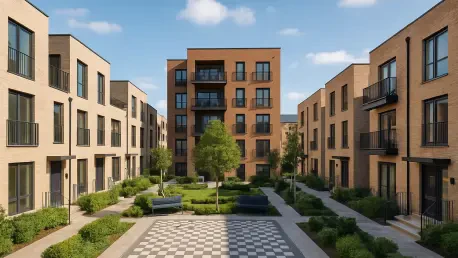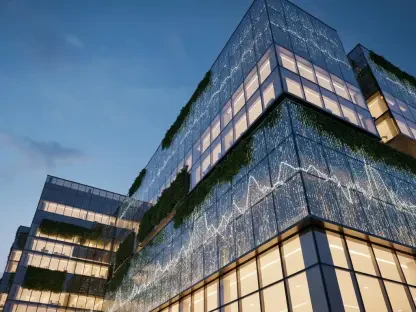I’m thrilled to sit down with Luca Calarailli, a seasoned expert in construction with a deep background in design and architecture. Luca has been closely following the evolving landscape of urban development in areas like Thamesmead and Plumstead in London, where ambitious housing projects are reshaping communities. Today, we’re diving into the details of the Lombard Square development near Plumstead station, a project that’s sparking conversation with its recent increase in planned homes and innovative design tweaks. Our discussion will explore the goals of this project, the reasoning behind key changes, and how it fits into the broader growth of the area.
Can you give us an overview of what’s happening with the Lombard Square development near Plumstead station?
Thanks for having me. Lombard Square is an exciting project on the boundary between west Thamesmead and Plumstead, aiming to deliver a significant number of new homes—now up to 1,964 with the latest plans. The first plot has already been approved, and construction is moving forward. This development isn’t just about housing; it’s about creating a sustainable community space that integrates with the local fabric. It’s a response to the growing demand for housing in southeast London while trying to balance design, accessibility, and livability.
What’s driving the recent increase in homes from 1,913 to 1,964 at Lombard Square?
The bump of 51 additional homes comes down to a mix of market demand and planning optimization. There’s a clear need for more housing in this part of London, especially with the population growth in areas like Thamesmead and Plumstead. Developers are also looking at how to maximize the use of space without compromising the quality of the project. This increase reflects a fine-tuning of the original vision to meet those pressing needs while still adhering to local planning guidelines.
How do these additional homes impact the overall design or layout of the project?
Adding more homes often means rethinking the layout to ensure the development doesn’t feel overcrowded. At Lombard Square, this has led to some clever design adjustments, like redistributing unit sizes and tweaking building heights. One block is getting taller, while another is shorter, which helps balance the skyline and maintain a sense of openness. It’s all about ensuring the project remains visually appealing and functional for future residents.
Speaking of building heights, can you explain why one block is taller and another shorter in the revised plans?
The height adjustments are largely about achieving a harmonious design while addressing practical concerns like sunlight, views, and density. Making one block taller allows for more units in a smaller footprint, which can preserve open spaces elsewhere on the site. Lowering another block might be a response to concerns about overshadowing nearby areas or maintaining a certain aesthetic. These decisions are often a balancing act between maximizing space and respecting the surrounding environment.
How do these height changes affect the look and feel of the development for the community?
Visually, these changes help create a more dynamic skyline, avoiding a monotonous row of identical buildings. A taller block can act as a landmark, giving the development a distinct identity, while a shorter one might soften the transition to neighboring areas. For the community, it’s about ensuring the project doesn’t feel imposing. The goal is to blend the new with the old, so residents—both new and existing—feel a sense of connection rather than disruption.
The plans also show a shift toward more smaller flats. What’s the thinking behind this focus?
Smaller flats are often a strategic response to housing trends and affordability challenges. They cater to a growing demographic of young professionals, singles, or small families who need compact, cost-effective living spaces in well-connected areas like Plumstead. It’s also a way to increase the total number of units without sprawling the development further. This shift reflects a broader push in urban planning to diversify housing options and make city living accessible to more people.
Who do you think these smaller flats are primarily designed for?
I’d say they’re mainly aimed at first-time buyers and renters—people who are looking for an entry point into the housing market or a flexible living arrangement. Given the location near Plumstead station, with good transport links, these flats are ideal for commuters or younger residents who prioritize convenience over space. They’re also likely to appeal to investors looking at the build-to-rent model, which is a big part of this project.
How does this development tie into the broader housing growth happening in Thamesmead and Plumstead?
Lombard Square is part of a larger wave of regeneration in the area. Nearby, you’ve got projects like the 294-home site by the rebuilt college and another 333-home development at a former care home. Together, these initiatives are transforming Thamesmead and Plumstead into more vibrant, residential hubs. They share a common goal of addressing housing shortages while improving local infrastructure and amenities. Lombard Square, with its scale and mixed-use potential, acts as a cornerstone in this wider transformation.
What role do you see partnerships playing in projects like this, especially with different focuses like build-to-rent?
Partnerships are crucial for large-scale developments like Lombard Square. You’ve got different entities bringing their expertise to the table—one focusing on social or affordable housing, while another, with its build-to-rent division, targets a rental market with high-quality, managed properties. This split allows for a diversity of housing options. Build-to-rent, in particular, is shaping up to be a game-changer, offering residents long-term rental stability with the perks of modern design and amenities, which isn’t always the case in traditional rental markets.
Looking ahead, what’s your forecast for housing growth in areas like Thamesmead and Plumstead over the next decade?
I’m optimistic about the trajectory. These areas are poised for significant growth, driven by their relative affordability compared to central London and improving transport links, even if some projects like the Bus Rapid Transit are delayed. Over the next ten years, I expect to see more mixed-use developments that blend housing with commercial and community spaces. The challenge will be ensuring this growth doesn’t outpace infrastructure or alienate existing communities. If done right, Thamesmead and Plumstead could become models for sustainable urban expansion in London.









